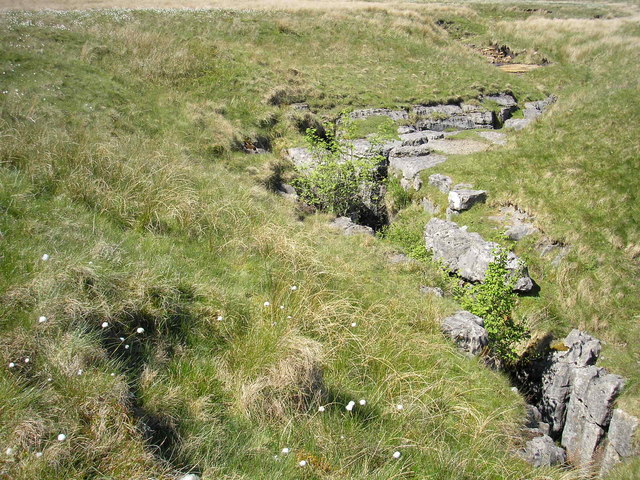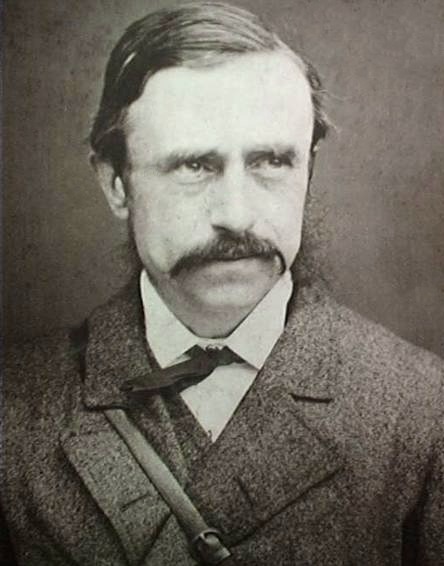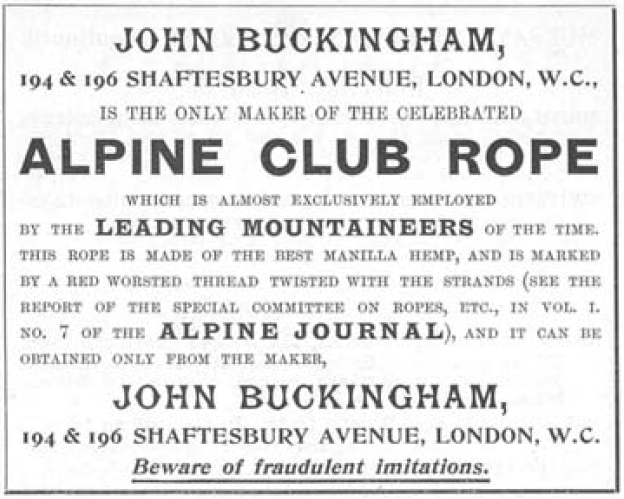|
John Birkbeck
John Birkbeck (6 July 1817 – 31 July 1890) was a Yorkshireman, banker, alpinist, and pioneer potholer. Early life and career Born in Settle and educated at the local Giggleswick School and Trinity College, Cambridge (although, as a Quaker, he could not take a degree) he spent most of his life in his home town where he was a partner in the Craven Bank, which his family had established in 1791. He was also a justice of the peace in later life. The family home was Anley (now a nursing home). Caving His name is remembered for his involvement in some early explorations of some of the potholes of Ingleborough, especially Gaping Gill and Alum Pot, although the records are sparse. Around 1842, Birkbeck had the water from Fell Beck diverted down 'the Birkbeck Trench' and went first 100 and then 190 feet down the Main Shaft of Gaping Gill, where there is a ledge which now bears his name, but then 'barred further descent'; no further attempts reached the bottom until Martel reache ... [...More Info...] [...Related Items...] OR: [Wikipedia] [Google] [Baidu] |
Settle, North Yorkshire
Settle is a market town and civil parish in the Craven district of North Yorkshire, England. Historically in the West Riding of Yorkshire, it is served by Settle railway station located near the town centre, and Giggleswick railway station which is a mile away. It is from Leeds Bradford Airport. The main road through Settle is the B6480, which links to the A65, connecting Settle to Leeds, Ilkley, Skipton and Kendal. The town had a population of 2,421 in the 2001 Census, increasing to 2,564 at the 2011 Census. History Settle is thought to have 7th-century Anglian origins, its name being the Angle word for settlement. Craven in the ''Domesday Book'' shows that until 1066 Bo was the lord of Settle but after the Harrying of the North (1069–1071) the land was granted to Roger de Poitou. In 1249 a market charter was granted to Henry de Percy, 7th feudal baron of Topcliffe by Henry III. A market square developed and the main route through the medieval town was aligned on ... [...More Info...] [...Related Items...] OR: [Wikipedia] [Google] [Baidu] |
Giggleswick School
Giggleswick School is a public school (English independent day and boarding school) in Giggleswick, near Settle, North Yorkshire, England. Early school In 1499, Giggleswick School was founded on half an acre of land leased by the Prior and Convent of Durham, to James Carr, the chantry priest at the parish Church of St Alkelda, to enclose and build, at his own expense, one 'Gramar Scole'. By 1512 the school consisted of two small, irregular buildings, next to the parish church. The school was run by the chantry priests until Edward VI dissolved the position. The school was saved by the petition of the King's Chaplain, John Nowell, and in 1553 it received its royal charter. The charter granted land and endowed it with the title: The Free Grammar School of King Edward the VI of Giggleswick. There is some evidence that there was a school on the same site from an earlier date. Giggleswick has claims to be one of the oldest public schools, although claims vary depending on the ... [...More Info...] [...Related Items...] OR: [Wikipedia] [Google] [Baidu] |
Trinity College, Cambridge
Trinity College is a constituent college of the University of Cambridge. Founded in 1546 by Henry VIII, King Henry VIII, Trinity is one of the largest Cambridge colleges, with the largest financial endowment of any college at either Cambridge or University of Oxford, Oxford. Trinity has some of the most distinctive architecture in Cambridge with its Trinity Great Court, Great Court said to be the largest enclosed courtyard in Europe. Academically, Trinity performs exceptionally as measured by the Tompkins Table (the annual unofficial league table of Cambridge colleges), coming top from 2011 to 2017. Trinity was the top-performing college for the 2020-21 undergraduate exams, obtaining the highest percentage of good honours. Members of Trinity have been awarded 34 Nobel Prizes out of the 121 received by members of Cambridge University (the highest of any college at either Oxford or Cambridge). Members of the college have received four Fields Medals, one Turing Award and one Abel ... [...More Info...] [...Related Items...] OR: [Wikipedia] [Google] [Baidu] |
Ingleborough
Ingleborough () is the second-highest mountain in the Yorkshire Dales, England. It is one of the Yorkshire Three Peaks (the other two being Whernside and Pen-y-ghent), and is frequently climbed as part of the Three Peaks walk. A large part of Ingleborough is designated as a Site of Special Scientific Interest and National Nature Reserve and is the home of a new joint project, Wild Ingleborough, with aims to improve the landscape for wildlife and people. Name The first element of the name "Ingleborough" has been variably explained as a Scots term for 'beacon, fire', an Old Danish term meaning 'English' or a derivative of Old English ''ing'', 'peak'. The second element is derived from the Old English word ''burh'', meaning "a fortified place"; in this case, a hill fort. The summit plateau of Ingleborough is encircled by the remains of a massive stone rampart, containing the foundations of Iron Age huts. Geography Ingleborough is in the south-western corner of the Yorkshi ... [...More Info...] [...Related Items...] OR: [Wikipedia] [Google] [Baidu] |
Gaping Gill
Gaping Gill (also known as Gaping Ghyll) is a natural cave in North Yorkshire, England. It is one of the unmistakable landmarks on the southern slopes of Ingleborough – a deep pothole with the stream Fell Beck flowing into it. After falling through one of the largest known underground chambers in Britain, the water disappears into the bouldery floor and eventually resurges adjacent to Ingleborough Cave. The shaft was the deepest known in Britain, until Titan in Derbyshire was discovered in 1999. Gaping Gill still retains the records for the highest unbroken waterfall in England and the largest underground chamber naturally open to the surface. Features Due to the number of entrances which connect into the cave, many different routes through and around the system are possible. Other entrances include Jib Tunnel, Disappointment Pot, Stream Passage Pot, Bar Pot, Hensler's Pot, Corky's Pot, Rat Hole, and Flood Entrance Pot. The Bradford Pothole Club around Whitsun May ... [...More Info...] [...Related Items...] OR: [Wikipedia] [Google] [Baidu] |
Alum Pot
Alum Pot is a pothole with a large open shaft at a surface elevation of on the eastern flanks of Simon Fell, North Yorkshire, England. It connects with nearby Long Churn Cave and Diccan Pot. The pot is accessed via a 1-km private track on payment of a small fee from Selside Farm in the hamlet of Selside in Ribblesdale. Alum Pot has variously been known as Allan, Alan, Allen, Hellen and Hell'n. History In 1847 John Birkbeck undertook the first partial descent of Alum Pot from Long Churn Cave which did not reach the floor of the shaft. He returned the following year and made a successful descent, when a group of nine men were lowered to the shaft floor in a large bucket winched down by a group of railway workers. Another successful complete descent of Alum Pot took place in 1870, when a group of people were lowered to the floor using a cage and windlass operated by navvies working on the Settle–Carlisle Line. In 1932 a 24-strong group of cavers from the Craven Pothole Cl ... [...More Info...] [...Related Items...] OR: [Wikipedia] [Google] [Baidu] |
Édouard-Alfred Martel
Édouard-Alfred Martel (1 July 1859, Pontoise, Val-d'Oise – 3 June 1938, Montbrison), the 'father of modern speleology', was a world pioneer of cave exploration, study, and documentation. Martel explored thousands of caves in his native France and many other countries, popularised the pursuit of cave exploration, introduced the concept of speleology as a distinct area of scientific study, maintained an extensive archive, and in 1895 founded , the first organisation devoted to cave science in the world. Life and Exploration Édouard-Alfred Martel was born in Pontoise, Seine-et-Oise on 1 July 1859. Born into a family of lawyers, he studied at the Lycée Condorcet in Paris. Early on, he became passionate about geography and the natural sciences and in 1877 he won first prize in an open competition for geography. He was a great reader of the works of Jules Verne. In 1866, while holidaying with his parents, he visited the Caves of Gargas in the Pyrenees. Other trips allowed him ... [...More Info...] [...Related Items...] OR: [Wikipedia] [Google] [Baidu] |
William Boyd Dawkins
Sir William Boyd Dawkins (26 December 183715 January 1929) was a British geologist and archaeologist. He was a member of the Geological Survey of Great Britain, Curator of the Manchester Museum and Professor of Geology at Owens College, Manchester. He is noted for his research on fossils and the antiquity of man. He was involved in many projects including a tunnel under the Humber, a Channel Tunnel attempt and the proving of coal under Kent. Background Dawkins was born in Wales at Buttington Vicarage in Montgomeryshire on 26 December 1837. He attracted attention at age five by collecting fossils from the local colliery spoil heaps. Soon after, his family moved into England to Fleetwood in Lancashire, where he attended Rossall School. He again attracted attention by adding fossils from the local boulder clay to his earlier collection. After leaving school, he attended Jesus College, Oxford. He graduated with a second in Classics and a first in Natural Sciences. On leaving O ... [...More Info...] [...Related Items...] OR: [Wikipedia] [Google] [Baidu] |
Monte Rosa
: , other_name = Monte Rosa massif , translation = Mount Rose , photo = Dufourspitze (Monte Rosa) and Monte Rosa Glacier as seen from Gornergrat, Wallis, Switzerland, 2012 August.jpg , photo_caption = Central Monte Rosa massif, with Dufourspitze to the south (right) and Nordend to the north (left), the Monte Rosa Glacier right below on its western wing, the upper Gorner Glacier on the left, and the Grenzgletscher to the right , country_type = Countries , country = , subdivision1_type = Canton, Regions , subdivision1 = , parent = Pennine Alps, Western Alps , listing = Country high point Canton high pointUltra , length_km = , length_orientation= , width_km = , width_orientation = , geology = , orogeny = , highest = Dufourspitze , elevation_m = 4634 , range_coordinates = , coordinates = , map = Switzerland , map_ ... [...More Info...] [...Related Items...] OR: [Wikipedia] [Google] [Baidu] |
Alpine Club (UK)
The Alpine Club was founded in London in 1857 and is the world's first mountaineering club. The primary focus of the club is to support mountaineers who climb in the Alps and the Greater Ranges of the world's mountains. History The Alpine Club was founded on 22 December 1857 by a group of British mountaineers at Ashley's Hotel in London. The original founders were active mountaineers in the Alps and instrumental in the development of alpine mountaineering during the Golden Age of Alpinism (1854–1865). E. S. Kennedy was the first chairman of the Alpine Club but the naturalist, John Ball, was the first president. Kennedy, also the first vice-president, succeeded him as president of the club from 1860 to 1863. In 1863, the club moved its headquarters to the Metropole Hotel. The Alpine Club is specifically known for having developed early mountaineering-specific gear including a new type of rope. The goal was to engineer a strong and light rope that could be carried easily ... [...More Info...] [...Related Items...] OR: [Wikipedia] [Google] [Baidu] |
John Ball (naturalist)
John Ball (20 August 1818 – 21 October 1889) was an Irish politician, naturalist and Alpine traveller. Background and education Ball was born in Dublin, the eldest son of Nicholas Ball, judge of the Court of Common Pleas (Ireland) and his wife Jane Sherlock. He was educated at Oscott College near Birmingham, and at Christ's College, Cambridge, where he was 41st Wrangler but as a Roman Catholic could not be admitted to a BA degree. He showed in his early years a taste for natural science, particularly botany; and after leaving Cambridge he travelled in Switzerland and elsewhere in Europe and North Africa, studying his favourite pursuits, and contributing papers on botany and the Swiss glaciers to scientific periodicals. Political career In 1846 Ball was made an assistant poor-law commissioner, but resigned in 1847, and in 1848 stood unsuccessfully as a parliamentary candidate for Sligo. In 1849 he was appointed second poor-law commissioner, but resigned in 1852 and success ... [...More Info...] [...Related Items...] OR: [Wikipedia] [Google] [Baidu] |
Caving In The United Kingdom
Recreational caving in the United Kingdom dates back to the mid-19th century. The four major caving areas of the United Kingdom are North Yorkshire, South Wales, Derbyshire, and the Mendips. Minor areas include Devon, North Wales, and the Scottish Highlands. Caving grew in popularity in the 1950s and 60s through participation in caving clubs. There are about 4,000 active cavers in the UK and nearly twenty times that number who attend instructor-led courses each year in caves around the country. In addition, many tourists visit show caves such as Wookey Hole Caves. Cave diving is a niche technical area of caving practised in the UK since the 1930s. This skill enables cavers to explore water-filled cave passages in Britain, and around the world. In recent years, British cave divers have been called on internationally for cave rescues and recoveries. History Before modern caving developed, John Beaumont wrote detailed descriptions of some Mendip caves in 1681, and in 1780 Jo ... [...More Info...] [...Related Items...] OR: [Wikipedia] [Google] [Baidu] |









